
If you are new to cloth diapering, you might be curious about all the terminologies as well as abbreviations. Below are several common terms that you might see on our website, in various product reviews, or on the World Wide Web (WWW).
We will be updating this list frequently. Feel free to offer suggestions about terms and/or abbreviations to include in the dictionary. In case a term/abbreviation(s) is not in the dictionary, please let us know!
A
Adjustable Insert: Another term for “one-size insert.” (See “One-size Insert”)
AI2: Abbreviation for “All-in-two.” (See “All-in-two”)
AI3: Abbreviation for “All-in-three.” (See “All-in-three”)
AIO: Abbreviation for “All-in-one.” (See “All-in-one”)
Agitate: To swish, swirl, or shake in water. This word is often used to describe how an insert can come out of certain brands of pocket diapers on its own in the wash (for example, “the insert is self-agitating”) or to describe a swirling motion you might use to rinse poop off of a dirty diaper (Padded Tush Stats, 2016).
Air-dry: The process in which a diaper is dried by air. Diapers are hung in single layers in a dry warm place, and the natural airflow dries the diapers. Air-drying is most commonly done on a shady outdoor clothesline, but can also be done on a drying rack (either indoors or outside) or on a clothesline indoors. A dryer is not used in this process (Padded Tush Stats,2016).
For air-drying, the energy for the movement of particles come from the displacement of air to the wind. In this process, known as convection, the mass of air stirs and "pushes" the water molecules out of the clothe, drying the clothe (Portilho, 2017).
Sun dry: The process in which a diaper is dried by sunlight outside on a shadeless outdoor clothesline.
For sun drying, the heat of the sun provides thermal energy for the water molecules to begin to move. The water molecules detach themselves and go into the atmosphere in the form of vapor. When all the molecules come loose, the clothes will be dry (Portilho, 2017).
Clothes will dry the fastest when hung up outdoors in a dry, sunny, hot, windy climate (Baird, 2015).
For those who live in a humid, overcast (means almost all of the sky is cloud covered), cold, non-windy climate, clothes will dry the fastest when hung indoors in a room with low humidity, high temperature, lots of light, and moving air. In other words, turn up the heat, turn up the dehumidifier, turn on some fans, and open the curtains (but not the windows) if you want to maximize drying rates (Baird, 2015).
For those of us who live in regions that are between the two extremes (dry, sunny, hot, windy climate; and humid, overcast, cold, non-windy climate), to determine whether outdoors or indoors is better, we need to ask ourselves the questions: Is the outdoor air less humid than the indoor air? Is the outdoor air warmer than the indoor air? Is outdoors brighter than indoors? Is outdoors windier than indoors?
If the answer to most of the above questions is "yes," then the clothes will dry faster outdoors. The worst place to dry clothes is in a damp, dark, cold, unventilated basement (Baird, 2015).
Photo Credit: Padded Tush Stats
Air-dry
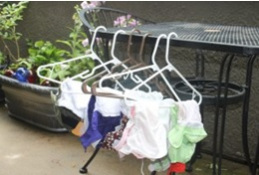
All-in-three (or AI3): A kind of diaper that can be used as a cover over any insert, as a pocket diaper, or as an AI2 with an insert snapped or laid into it.
Photo Credit: Padded Tush Stats
AI3
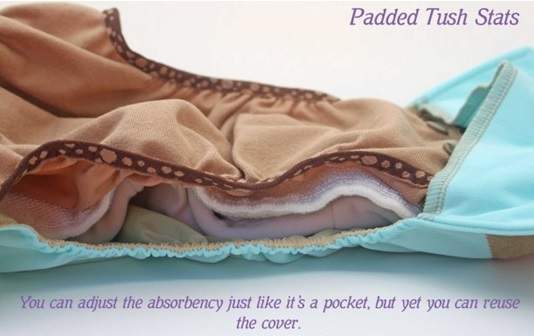
Ammonia Buildup: Ammonia buildup in diapers can be caused by using too much detergent or by not rinsing or washing diapers thoroughly enough to remove bacteria. Stripping the diapers will eliminate the problem.
All-in-one (AIO): A kind of diaper where an insert is sewn into the diaper.
Photo Credit: Padded Tush Stats
AIO
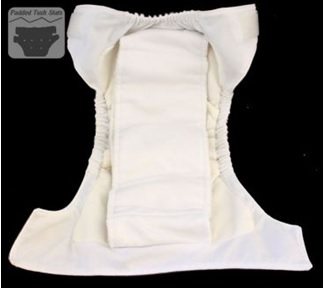
All-in-two (AI2): An AI2 diaper has a set of snaps that attach the absorbent layers (inserts) to the inside of the diaper. When changing an AI2 diaper, you can either replace the insert with clean BoyGirl AI2 Spare Inserts and reuse the same diaper cover, or replace the entire diaper if needed. This can help stretch your diaper shillings/dollars. The top of the AI2 diaper and its insert (the part touching the baby’s bottom) are usually built with a stay-dry fabric that wicks moisture away from the baby’s bum and helps prevent rashes.
Photo Credit: Padded Tush Stats
AI2
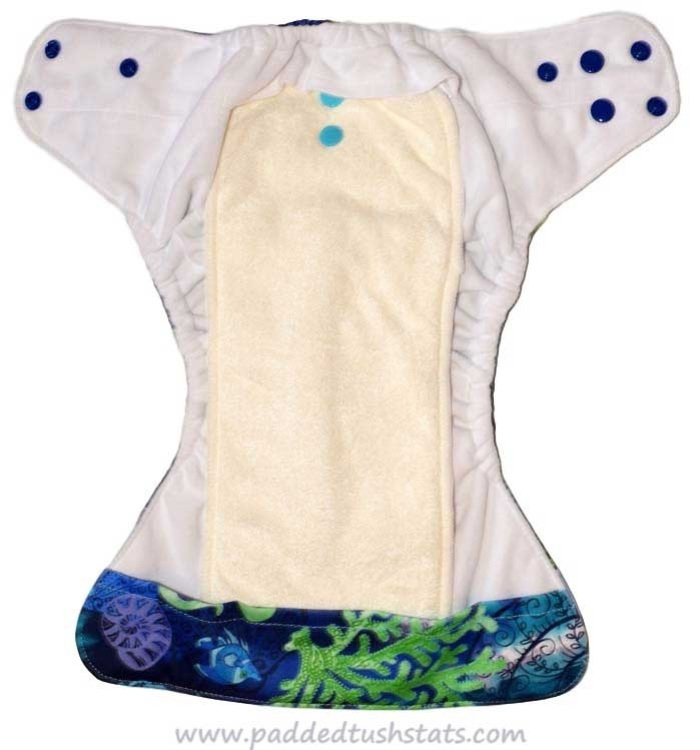
AP: An abbreviation for Attachment Parenting, a common term in the cloth diapering (CD) community.
Aplix: Usually referring to the type of closure on a diaper. Aplix is commonly known as Velcro or Hook & Loop type of closure. Easy to attach; just like a disposable diaper (Kelly Closet, 2016; Padded Tush Stats, 2016).
Photo Credit: Padded Tush Stats
Aplix
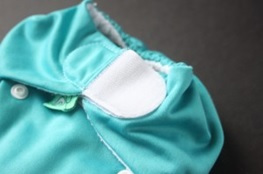
B
Baking Soda: An ancient housewife’s remedy for odor control; many people have found it useful for controlling diaper pail odor.
Bamboo: Bamboo is a fabric that is very soft and highly absorbent while still remaining trim. It has excellent wicking properties and can be antimicrobial (can be antibacterial and antifungal).
Please note: DryBamboo Diaper Liners and Baby Wipes from Canagoza are made from bamboo viscose fiber. All other bamboo (or bamboo found in bamboo-cotton blend) cloths and clothing from Canagoza are made from regenerated bamboo fiber (regenerated using amine oxide, which is a weak base).
BBC: Abbreviation for “Babycenter,” a popular online parenting forum.
BBOS: Abbreviation for Best Bottom One Size diapers.
BF: An abbreviation for breastfeeding. Breasting is also abbreviated bfing.
Birdseye Cotton: One of the most basic fabrics used in diapering. Traditional prefolds and some modern-day cloth diapers are made with birdseye. It is quick drying and very absorbent when multiple layers are used.
Photo Credit: Padded Tush Stats
Birdseye Cotton
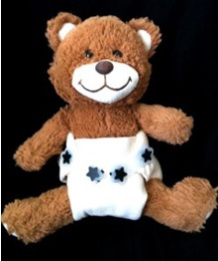
Booster: Another word for doubler. A booster refers to an insert that can be added to boost the absorbency of a diaper. A booster is similar to an insert that can be added to “double” the absorbency of your diapers. A booster may be used with any type or style of diaper for added absorbency. Boosters can be helpful for nights, naps, and heavy wetters.
Photo Credit: Padded Tush Stats
Booster Insert
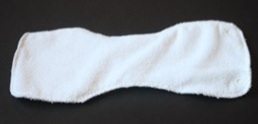
BoyGirl: A Canagoza's brand name for a cloth or clothing used or worn by both baby boys and girls.
Brick-and-mortar: An actual cloth diaper store that you can visit and shop at (rather than only being able to order online) (Padded Tush Stats, 2016).
Butt Fluff: Slang term for cloth diaper.
BW: Abbreviation for “Baby Wearing” (Padded Tush Stats, 2016).
C
Calgon: Water softener used in washing cloth diapers in hard water conditions. This is not the same as the “Calgon Take Me Away” body care items.
CD: Abbreviation for cloth diapers. Many moms refer to themselves as CDing moms.
CDS: Abbreviation for “Cloth Diaper Safe” that is often used when referring to rash ointments/remedies or laundry detergents.
Changing Mat: A soft, reusable, and washable fabric with a waterproof backing that is used to facilitate changing of a baby's diaper. A changing mat is designed to be carried in your diaper bag for diaper changes done on the go.
Cloth Training Pant: A waterproof undergarment for toddlers and children who are potty training. Can be pulled up and down and may have side snaps for easy removal in case of accidents. They vary in absorbency and how waterproof they are; if at all (they are intended to catch a small accident, but are not meant as a substitute for diapers) (Padded Tush Stats, 2016).
Photo Credit: Padded Tush Stats
Cloth Training Pant
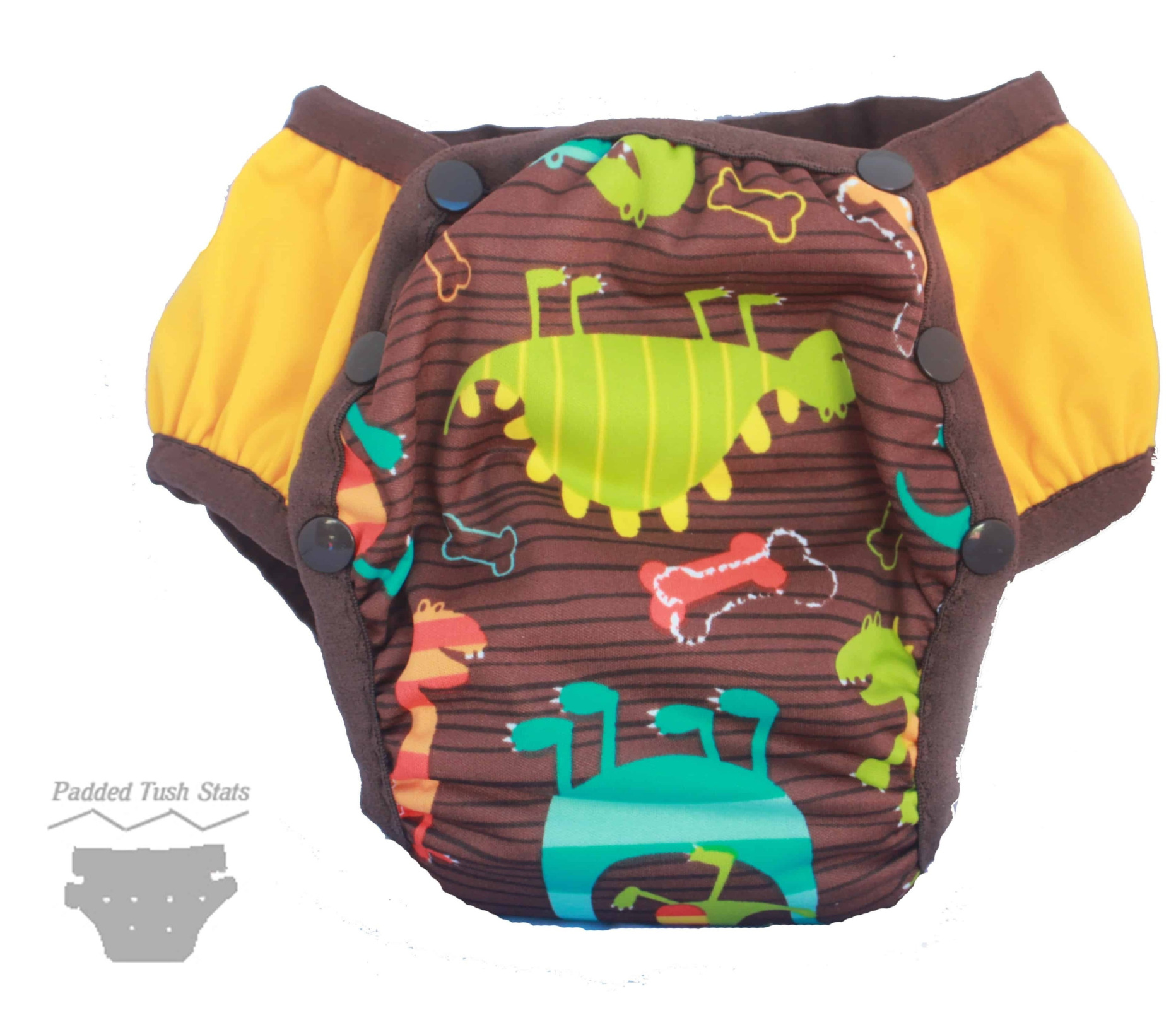
Cloth Wipes: Cloth wipes are reusable and washable fabric squares (or rectangles) used to cleanup a soiled baby bottom. Cloth wipes are usually made of bamboo. Bamboo wipes are also used in bathing a baby and as a handkerchief and daily face/hand wipe. You can pre-moisten the wipes (using a wipes warmer or similar container) or wet them at the time of use to wipe a baby's bottom. Wipes can be moistened with water or wipes solution. Wipes can be washed along with the rest of your cloth diaper laundry (Padded Tush Stats, 2016).
Photo Credit: Canagoza
Cloth Wipe
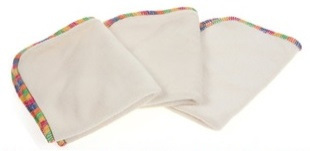
Coconut Oil: Natural oil that can be used to moisturize and protect baby’s diaper area. The oil can also be mixed with tea tree oil to use in cases of eczema and other skin conditions.
Compression Leaks: When the fluid is squeezed or "compressed" out of a diaper or insert, often by baby's own body weight when sitting. Microfiber fabrics are particularly prone to compression leaks, so parents will often pair a microfiber insert with a natural fiber insert (which absorbs slowly, but is not prone to compression leaks) to combat this issue. Additionally, parents may add a bamboo charcoal/bamboo cotton/hemp booster insert to combat compression leaks (Padded Tush Stats, 2016).
Contour: A kind of diaper that is similar to the fitted diaper, but requires a pin or other fastener to keep it closed. Some brands of contour diapers have elastic around the legs and back, but others do not (Padded Tush Stats, 2016).
D
Dawn Strip: A common method of stripping oil or soap buildup from diapers by using small amounts of blue Dawn dish soap in large amounts of water, followed by several rinses (Padded Tush Stats, 2016).
DD, DH, DS: Abbreviations commonly used on the Internet to refer to your family members. DD (dear daughter, darling daughter, darn daughter, etc), DH (dear husband, darling husband, darn husband, etc), DS (dear son, darling son, darn son, etc). Example: My DD slept through the night in her BoyGirl AI2 Dry Diaper.
Delaminating: A process in which the TPU on a PUL material begins to bubble or peel away from the fabric. This usually occurs due to use of low quality materials during manufacturing. Example: manufacturing of low quality PUL — manufacturing of generic PUL. Or, delaminating can occur because of aggressive laundering (abrasive detergent use, bleaching, high heat sanitizing cycles, and high heat drying). Or, it can occur because of excessive application of force on both sides of PUL (Padded Tush Stats, 2016).
Diaper Cover: A diaper cover is usually made of waterproof PUL (polyester laminated with TPU) fabric. It has a stay-dry material.
Photo Credit: Canagoza
Diaper Cover
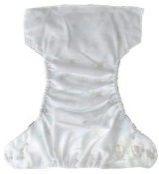
Diaper Duck: A plastic tong-like device that is helpful when dunking, swishing, and wringing out inserts and diaper covers.
Diaper Safe Detergent: Any number of brands of laundry detergent specifically marketed for cloth diaper washing. These detergents usually do not contain any additives (such as brighteners, softeners, enzymes, and among others) that could junk up the diapers or harm the baby.
Diaper Service: A service rendered by a local business, where they pick up your diapers one or more times per week, wash them, and return them to you. Often this service includes renting diapers from the business so that you never have to purchase diapers. Diaper services vary as to what they will provide in terms of diaper styles, but typically offer either fitteds or prefolds, and PUL covers (Padded Tush Stats, 2016).
Diaper Service Quality: High-quality prefolds.
Diaper Sprayer: A diaper sprayer is a device used to rinse dirty diaper over a toilet before it is put in the wash or wet/dry bag or wet bag (as an alternative to dunking and swishing the diaper in the toilet bowl – see “Dunk and Swish”). A diaper sprayer consists of a hose and sprayer and is connected to the water line of the toilet (attaches to most toilets in just a few easy steps). Some parents prefer diaper sprayers instead of disposable flushable bamboo viscose liners. Diaper sprayers work similar to kitchen sink hose attachments. Using a diaper sprayer will prevent you from getting poop in your washing machine. Simply flush away the poop after spraying.
Photo Credit: Padded Tush Stats
Diaper Sprayer
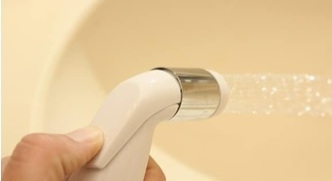
DIY: Abbreviation for “Do It Yourself.”
Dry Pail: A bucket (sometimes with a lid) that is used to store used cloth diapers and wipes.
Dryer Balls: Balls of felted wool yarn or roving that are used in the dryer to speed up drying time and reduce static cling. The more balls you use the quicker your diaper inserts or clothes will be dry (and you will consume less energy) (Padded Tush Stats, 2016).
Photo Credit: Padded Tush Stats
Dryer Balls
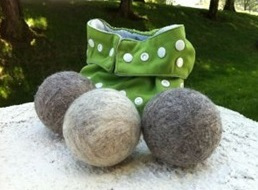
DS: (1) Abbreviation for “Diapered Son.” (2) Abbreviation for “Dear Son.” (3) Abbreviation for “Diaper Swappers,” a popular online cloth diaper forum and marketplace.
DSQ: Abbreviation for “Diaper Service Quality”. (See “Diaper Service Quality”)
Dunk and Swish: Swishing a poopy diaper in the toilet bowl by hand prior to putting it in the wash or wet bag (Padded Tush Stats, 2016).
E
EBF: A common abbreviation to refer to a baby that is exclusively breastfed. EBF poop does not need to be rinsed prior to washing because it is water soluble and will rinse clean in the laundry.
EC: Abbreviation for “Elimination Communication,” a method where the parent or caregiver learns (especially during potty training) the baby’s cues and takes them to a toilet to eliminate (pee/poo).
Encased Elastic: A method of sewing the elastic around the legs of a diaper that involves creating a channel to thread the elastic through (so that the elastic is fully encased in the fabric at the leg of the diaper). Encased elastic is found on the majority of diapers. The opposite of this style is aptly called un-encased elastic (Padded Tush Stats, 2016).
Photo Credit: Padded Tush Stats
Encased Elastic
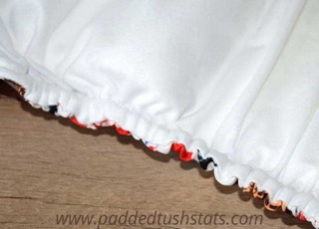
Enzymes: A component in many laundry detergents used to break down stains. Enzymes may cause diaper rashes on some babies.
EUC: Abbreviation for “Excellent Used Condition,” a way to classify a diaper’s condition when selling it (Padded Tush Stats, 2016).
F
Factory Seconds: A new, unused diaper that cannot be sold at regular prices through a retailer due to a flaw or blemish. Flaws or blemishes may be minor (such as a smudge that will easily wash away, a missed stitch, or incorrect dye lot) to more severe problems (such as crooked stitching or staining). These diapers are typically sold at a discount.
Family Cloth: Replacing some or all of your family’s biodegradable toilet paper with cloth wipes. Many families use them only for wiping urine, and continue to have toilet paper available for bowel movements and guest use.
Felting: The process of washing wool in hot water and usually drying it in a dryer. Felting shrinks the wool and tightens the weave of the knitted or crocheted fabric.
Fitted Diaper: A fabric diaper with no waterproof layer is referred to as a fitted diaper. Fitted diapers are usually cotton (or other natural fiber like hemp or bamboo) that goes on your baby with snaps or safety pins (depending on the brand). A fitted diaper requires a wipeable inner diaper cover to contain wetness and is great for nights, naps, or heavy wetters. Unlike other cloth diapers, a fitted diaper is absorbent all over the diaper and not just in the “wet zone.” Some brands of fitted diapers may have stay-dry liners to keep your baby feeling drier.
Photo Credit: Padded Tush Stats
Fitted Diaper
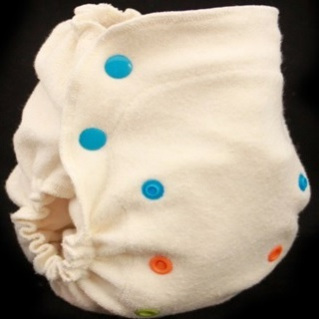
FL: Abbreviation for “Front Loader Washing Machine.”
Flat Insert: A flat diaper insert refers to a large flat piece (usually a single layer) of fabric (usually cotton, hemp, or other natural fiber) that can be folded and used as an insert in a cloth diaper. Flats are similar to prefolds, but without the thicker middle layer, and often referred to as “your Grandma’s diapers,” because they are similar to what the old-fashioned cloth diapers looked like. Flats are very budget friendly and great for traveling or camping because of their ability to easily hand wash. Flats can be used in emergency situations (natural disasters) if you run out of clean diapers. You can buy flats pre-sewn in packages. A diaper cover is required to contain wetness and a diaper pin or snappi may be needed to attach the flat around your baby.
Photo Credit: Padded Tush Stats
Flat Insert
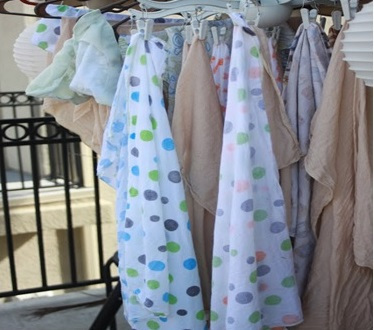
Fleece: One of the most common fabrics used on the inside of cloth diapers. Fleece allows wetness to pass through while still feeling dry to the touch. This helps to keep your baby’s bottom dry. You can also purchase small sheets of fleece to lay between your baby and a natural fiber (like cotton or hemp) to keep them feeling dry in prefolds, flats, or fitteds. See “Covers,” “Soakers,” “Longies,” “Shorties,” or “Skirties”).
Photo Credit: Padded Tush Stats
Fleece
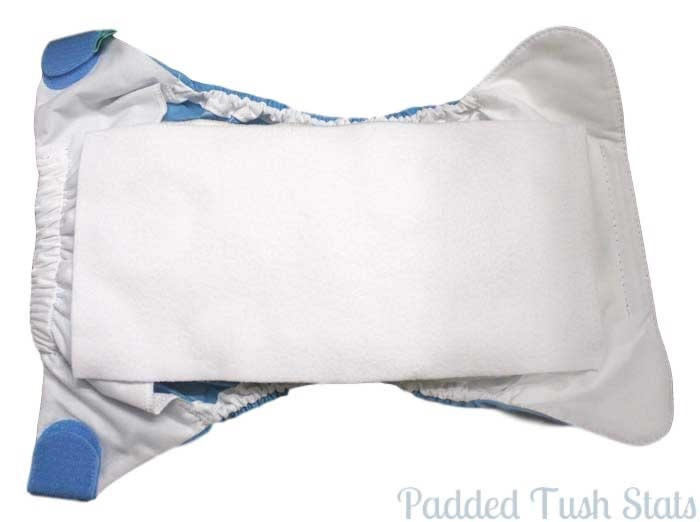
Fluff: Slang term for cloth diaper.
Fluff Bling: Cute appliqué patches that snap onto exposed snaps of a diaper.
Fluff Mail: Slang term for receiving cloth diapers in the mail.
FOE: Abbreviation for “Fold Over Elastic.” (See “Fold Over Elastic”)
Fold Over Elastic: Product used when sewing diapers. It is a type of elastic that has a crease down the center to be used on the trim to finish and bind the leg holes of some diaper patterns.
Photo Credit: Padded Tush Stats
Fold Over Elastic
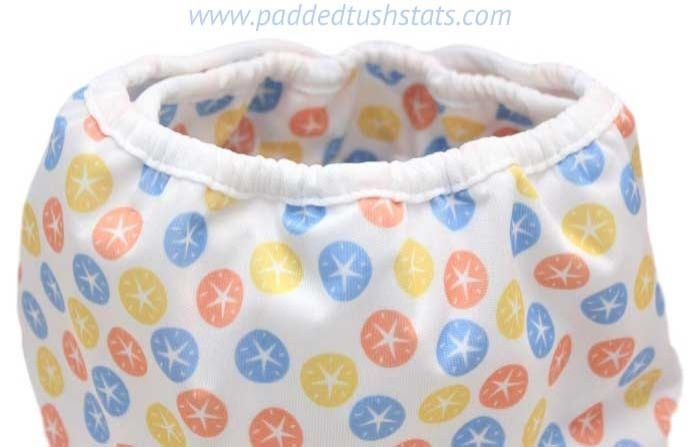
Fold Over Pocket: This is a flap of fabric that folds over a pocket diaper’s insert opening (or “pocket”) which prevents the insert from slipping outside of the shell (thus avoiding wicking).
FST: Abbreviation for “Flour Sack Towel,” an item that is the approximate size and thickness as a flat cloth diaper. It is great for diapering on a budget (Padded Tush Stats, 2016).
G
Gaping: When part of a diaper (such as the waistband or leg) does not lie flush against the skin, thereby increasing the possibility of a leak.
Grapefruit Seed Extract (GSE): A powerful, natural disinfectant that can be added to laundry detergent to disinfect cloth diapers and keep them free of bacteria. Only three to five (3-5) drops per load is necessary.
GUC: Abbreviation for “Good Used Condition,” a way to classify a diaper’s condition when selling it.
Gusset: The elastic part of a diaper around the baby’s leg. Double gussets are an additional row of elastic at the leg of a cloth diaper sewn internally. Double gussets offer an extra layer of protection to help contain messes. They provide superior leak protection. Sometimes, the double gussets are made of the same material as the lining of the diaper. Other double gussets use the same material as the outside or cover of the diaper, and they are finished the same way as the outside leg elastic (Padded Tush Stats, 2016).
Photo Credit: Padded Tush Stats
Gussett
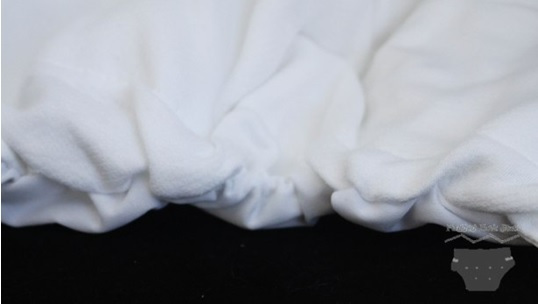
H
Hang Dry: Another term for “Air-dry.” (See “Air-dry”)
Hemp: A natural fiber used in diaper inserts and diaper doublers.
HE: Abbreviation for “High Efficiency Washing Machine.” Most of these are front loaders, but there are also top loading HE washing machines. The amount of water put into the machine is based on weight sensors, which is why many cloth diaper users put a damp towel in the machine in order to trick the machine into filling up with more water.
Hip Snap: An additional snap on the waist of a diaper spaced further back for smaller waisted diaper settings (usually on a one size diaper) which help prevent wing droop.
Photo Credit: Padded Tush Stats
Hip Snag
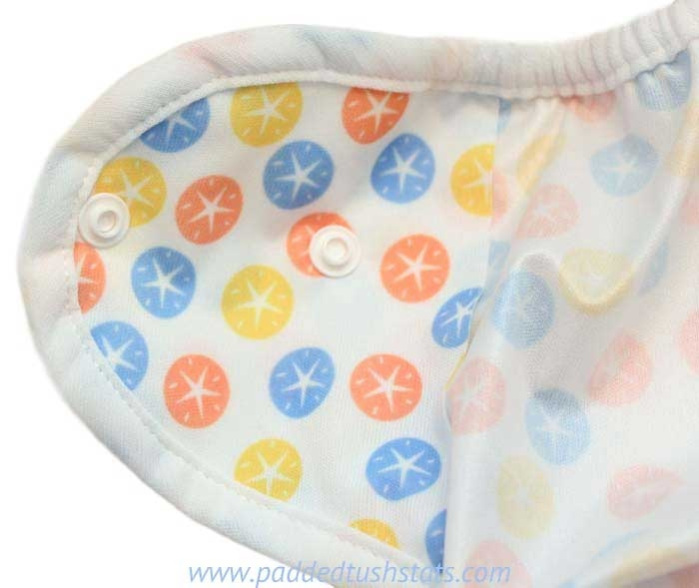
Hook and Loop: The common term for a kind of diaper closure. Most people know of it as “Velco,” but Velcro is just a brand (so it is like using the term “Kleenex” instead of “tissue paper"). Hook and Loop closure is the most similar to how a disposable diaper goes on and is easy to use. It is often considered to be daddy-friendly or day care friendly (Padded Tush Stats, 2016).
Photo Credit: Padded Tush Stats
Hook and Loop
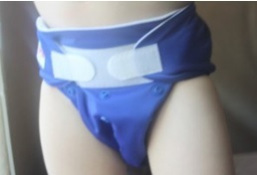
I
Infant Insert: Smaller, thinner insert used to make one size cloth diapers fit infants and small babies. Infant insert can also be used as a doubler for older babies. (See “Doubler”)
Photo Credit: Padded Tush Stats
Infant Insert
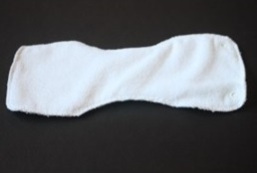
Insert: Inserts are the absorbent part of the cloth diaper. They are usually rectangular-shaped and usually consist of multiple layers of fabric sewn together. The most popular material is a microfiber/microterry material (a synthetic). Microfiber is, however, prone to compression leaks, so microfiber layers are paired with natural fiber layers, such as bamboo cotton and bamboo charcoal. Or, a microfiber insert is paired with a natural fiber insert/s. Inserts may also be hemp, bamboo, bamboo cotton, bamboo charcoal, organic cotton, or minky. Microfiber/microterry should not be placed directly next to your baby’s skin (instead it may be placed inside a pocket).
Photo Credit: Padded Tush Stats
Inserts
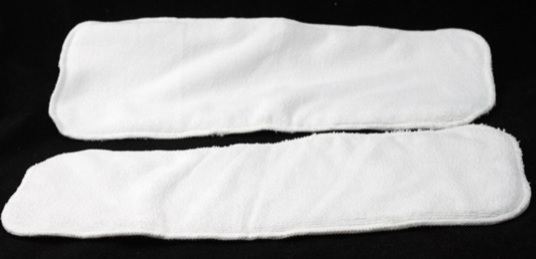
Interlock: A type of wool used to make longies, shorties, skirties, or covers. It is usually softer and thicker than merino or upcycled wool (Padded Tush Stats, 2016).
Photo Credit: Padded Tush Stats
Interlock
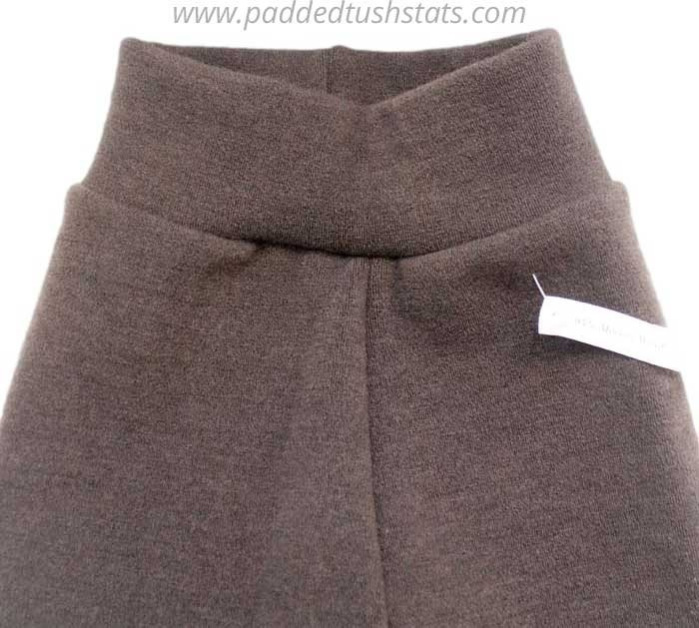
J
K
L
Lanolin/Lanolized: Wool covers (longies and shorties) need to be lanolized to waterproof them for use as diaper covers. A natural wax-line material comes from sheep once wool is harvested (animals are not harmed in the extraction of lanolin). Lanolin can also be used by nursing mothers for cracked, dry, and rough nipples (Padded Tush Stats, 2016).
Photo Credit: Padded Tush Stats
Lanolin
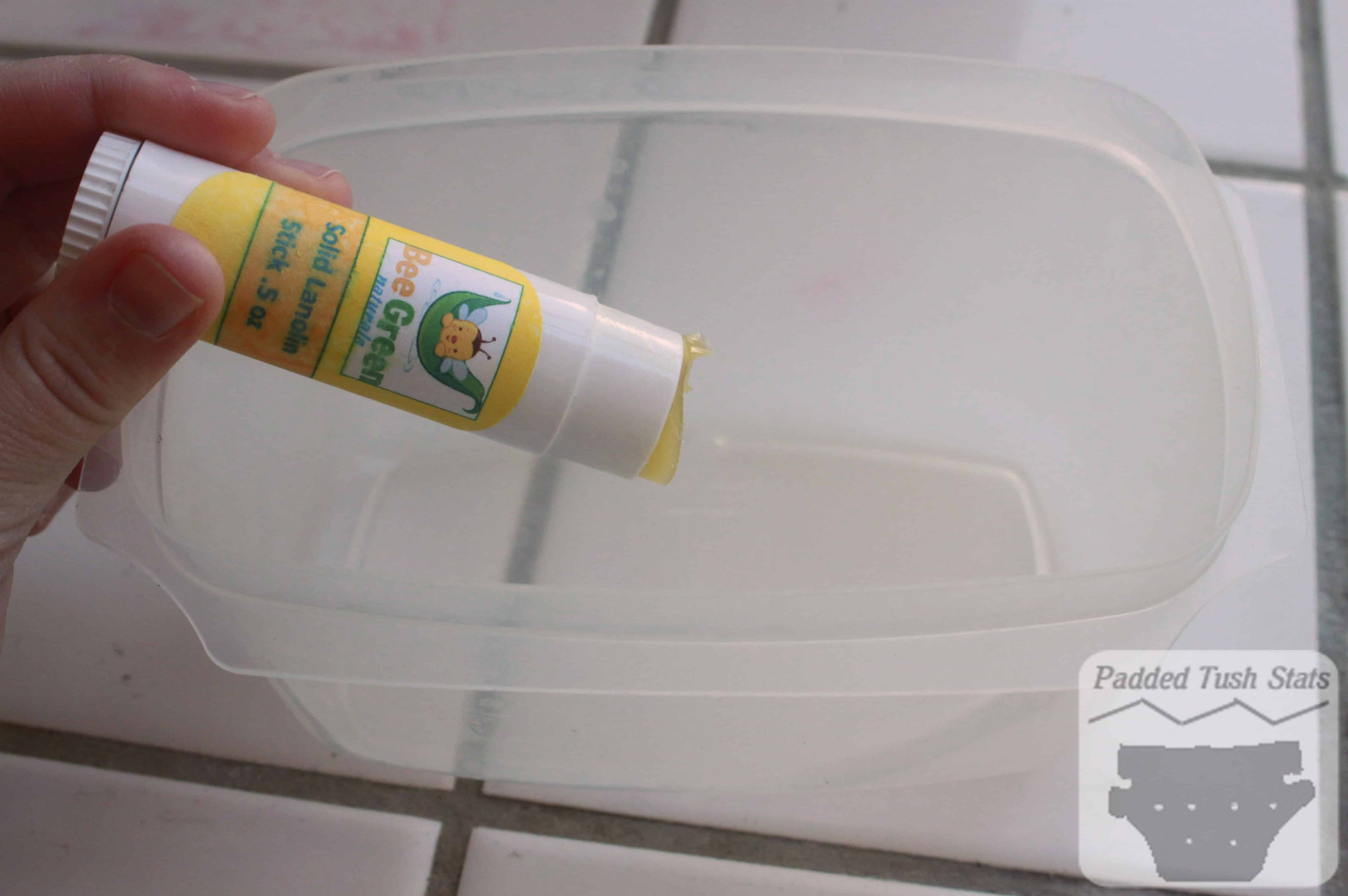
Lanolizing: A method of reapplying lanolin (see “Lanolin”) to woolen knit items so that they can retain their natural wicking and water repellent properties.
Photo Credit: Padded Tush Stats
Lanolizing
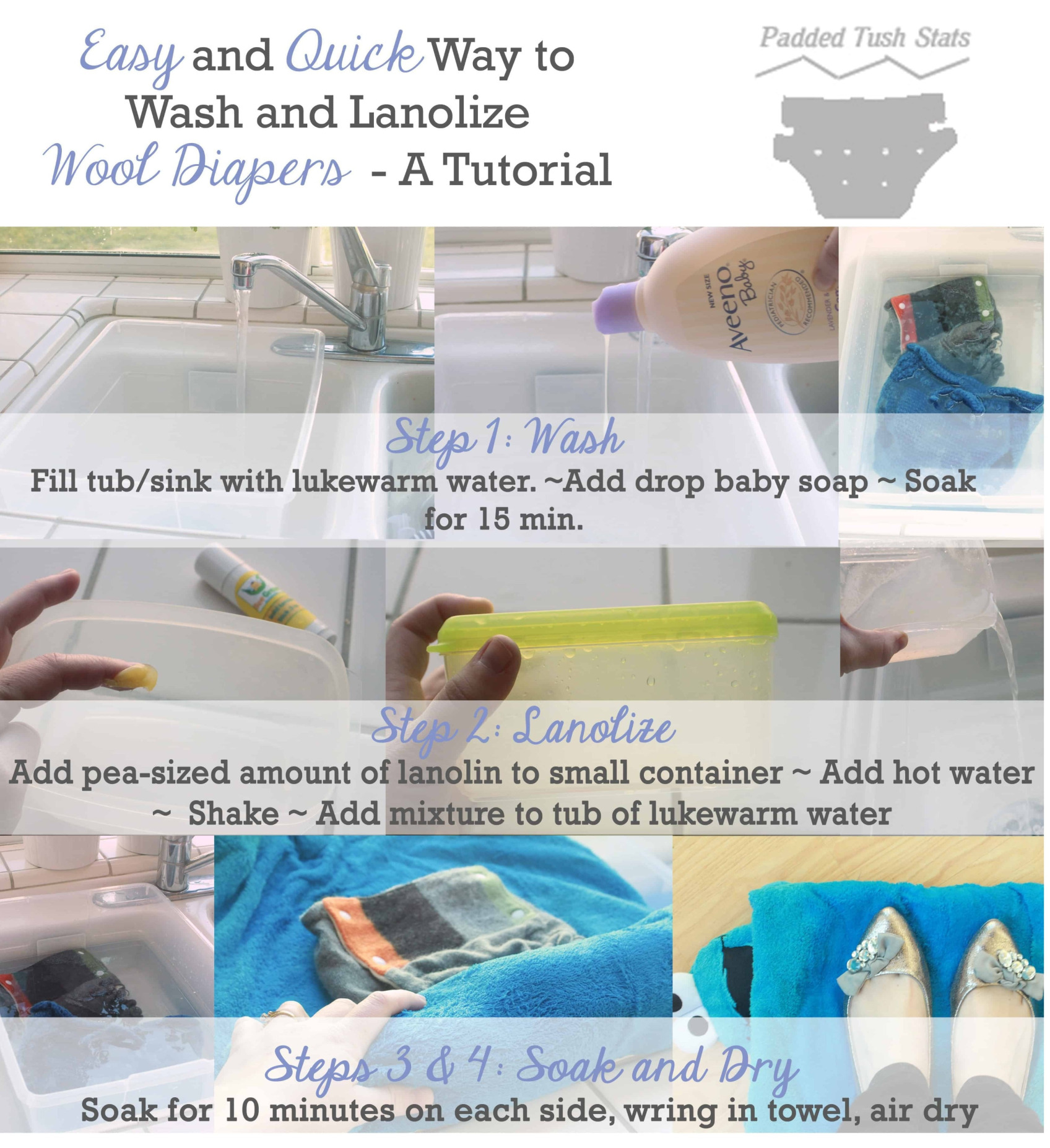
Laundry Tabs: On diapers with hook and loop closure, these allow you to secure down the tab so that it does not snag on other items in the wash.
Photo Credit: Padded Tush Stats
Laundry Tabs
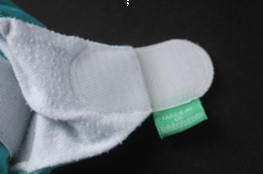
Liners: (1) Disposable flushable diaper/nappy liners, made from bamboo viscose, keep your baby’s bum drier and make it simple to cleanup diapers. In other words, liners are used to draw moisture away from baby’s bottom and make getting poo off a diaper easier. Disposable liners are thin sheets that are almost like toilet paper sheets — and usually look like dryer sheets. They lay into your diaper the same as reuseable ones, but they are meant to be thrown away. (2) Fleece liners are used to keep baby from feeling the wetness of the diaper. (3) Slang for pail liner (Padded Tush Stats, 2016).
Photo Credit: Padded Tush Stats
Disposable Flushable Diaper Liners
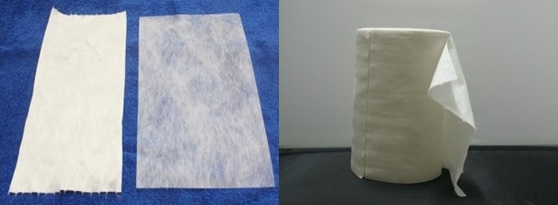
LO: Abbreviation for “Little One” (Padded Tush Stats, 2016).
Longies: These are wool or fleece pants that can be used to cover a diaper that is not waterproof.
Photo Credit: Padded Tush Stats
Longies
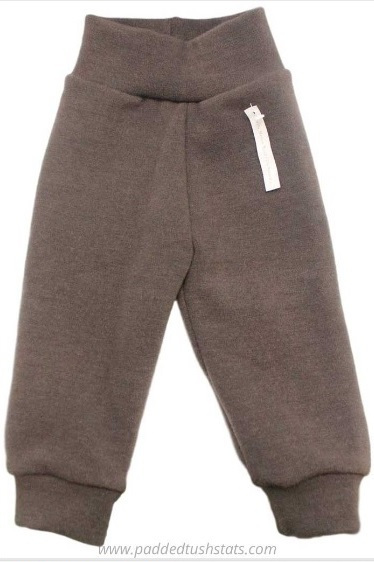
M
MF: Abbreviation for “Microfiber.” (See “Microfiber”)
Microfiber: A terry-like fabric made of synthetic fibers used for its ability to absorb moisture and attract debris. Microfiber is used to make inserts for diapers — and inner layers of training pants and sanitary pads.
Microfleece: A type of synthetic fabric used in diapers and liners as stay-dry material due to its ability to wick moisture away from baby’s skin.
Photo Credit: Padded Tush Stats
Microfleece
Minkee/Minky: A popular synthetic material (polyester microfiber) in the cloth diapering community that is super soft. Minky is soft, plush, and fuzzy fabric and used for both inserts and covers. Minky is softer to the touch than microfiber. Some minky is laminated to make it waterproof. Minkee can refer to the super soft (almost stuffed animal like) feel of the outside of diapers.
Photo Credit: Padded Tush Stats
Minky
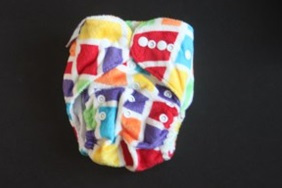
Minky Insert: A diaper insert made from minky fabric. (See “Minky”) (Padded Tush Stats, 2016).
N
Nappy: Another word for “diaper.” It is used mostly in European countries.
Natural Fabrics: Fabrics that are made from naturally occurring materials (that is, not synthetic fabrics), including bamboo and hemp. These fabrics are generally more durable.
Photo Credit: Padded Tush Stats
Fitted Diaper Made from Natural Fiber
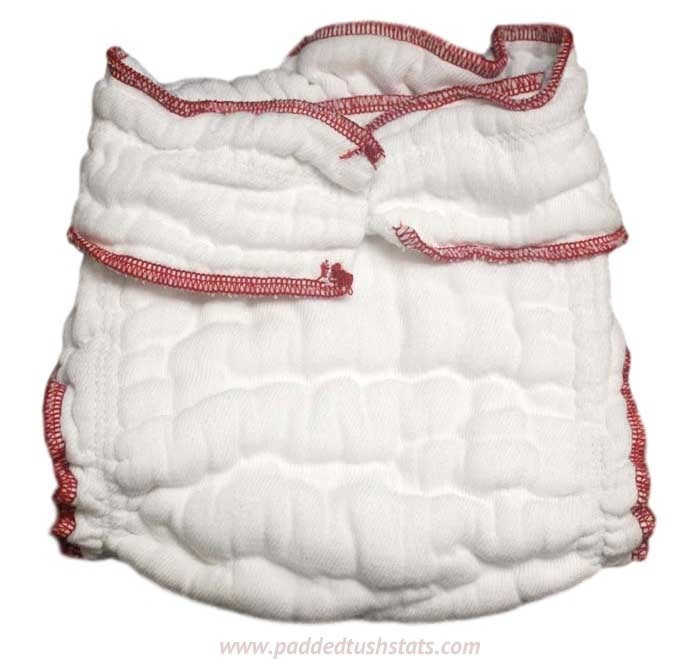
NB: Abbreviation for “Newborn.”
Newborn Diaper: Diapers that are designed to provide a good fit during the gap in age and weight from birth until a one size diaper will provide a good fit. These typically fit most babies at birth, generally 6-8 pounds, though some may even fit 5-10 pounds.
Photo Credit: Padded Tush Stats
Newborn Diaper
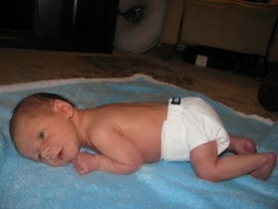
NIP: Abbreviation for “New In Packaging,” typically used in the selling or trading of diapers.
NWOT: Abbreviation for "New Without Tags," typically used in the selling or trading of diapers.
NWT: Abbreviation for “New With Tags,” typically used in the selling or trading of diapers (Padded Tush Stats, 2016).
O
OBF: Abbreviation for “Organic Bamboo Fleece.”
Photo Credit: Padded Tush Stats
Organic Bamboo Fleece
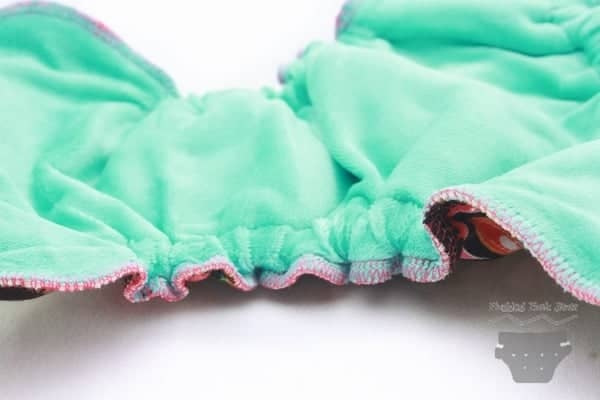
One-size Cloth Diaper: Refers to a diaper that fits most babies from birth through potty training. A one-size diaper can be adjusted to fit different shapes and sizes of babies from 3.5 kilograms to 16 kilograms. Sizing can either be adjusted using a snap down rise (See “Snap Down Rise”) or by adjusting the elastic in the leg casings.
Photo Credit: Padded Tush Stats
One-size Cloth Diaper
One-size Insert: An insert designed to go into a one size diaper that has snaps or marks which allow you to adjust the length of the insert to match the rise setting of the shell (Padded Tush Stats, 2016).
Photo Credit: Padded Tush Stats
One-size Insert
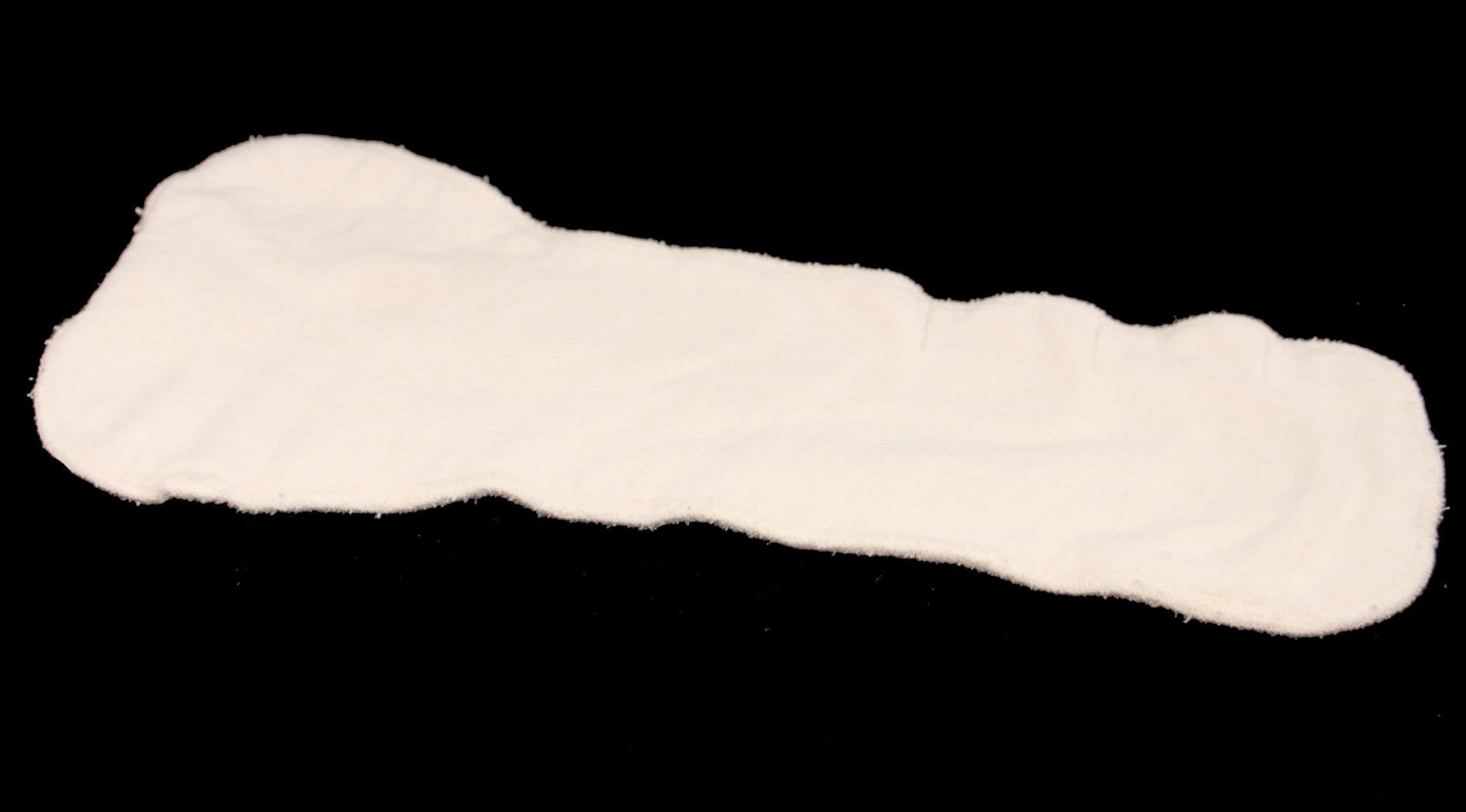
Organic Bamboo Fleece: It is made of 70% viscose bamboo and 30% organic cotton fibers.
OS: Abbreviation for “One Size.” (See “One-size Cloth Diaper”)
OTB: Abbreviation for “On The Bum,” a question many mamas pose to one another on forums or Facebook (for example, “What’s OTB today?”)
OTW: Abbreviation for “On The Way,” typically referring to when you have made a diaper purchase online and are awaiting it in the mail (Padded Tush Stats, 2016).
P
Pad Fold: A method of folding a flat diaper into a long rectangular pad which creates a lot of absorbency in the center. (See here for ways to fold flat diapers)
Photo Credit: Padded Tush Stats
Pad Fold
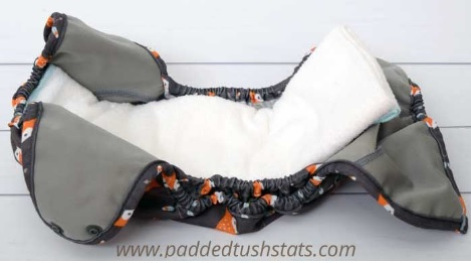
Pail Liner or Diaper Pail or Wet Bag: A diaper pail is used to store dirty diapers between washings. They are essentially a waterproof garbage bag, frequently with an elasticized top to hold it in place, which are made to be washed with the diapers and prevent the need to wash the diaper pail. These reusable bags are waterproof and can be used alone or placed inside a small trashcan. The diaper pail or liner can be washed along with your dirty diapers. Some diaper pails hang on hooks or door knobs for a more fashionable look. (See also wet bag).
Photo Credit: Kelly Closet
Pail Liner
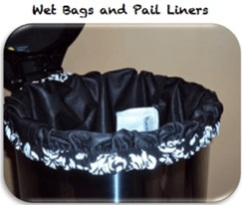
PF: Abbreviation for “Prefold.” (see “Prefold”)
Pilling: Little collected balls of fabric that stick out -- usually off of leg bindings, hook and loop, or inner fabrics -- with time. This can happen if they get worn or rubbed in a certain area (for example, if one area of hook and loop is used more often) or even just along the edges of things (where they are more likely to be rubbed). For most items where pilling occurs, the function is unaffected. The item, however, looks “worn” or “old.” (See “Pilling”) (Padded Tush Stats, 2016).
Pilly: An adjective used to describe fabric that is pilling.
PL: Abbreviation for “Potty Learning.”
Plastic Pants: Old-fashioned pull on diaper covers. These are still available for purchase very cheaply, but are less preferred than modern-day diaper covers.
PM: Abbreviation for “Private Message,” commonly used on diaper swapping sites. Can also be used as a verb (for example, “I PM’d you!”)
Pocket Diaper: A pocket-style diaper has a pocket (in one or both ends that you stuff an insert into) opening between the outer shell layer and the inner layer that touches baby’s skin. A diaper with an opening in one or both ends that you stuff an insert into. The top of the diaper (the part touching the baby’s bottom) is usually built with a “stay-dry” fabric that wicks moisture away from the baby’s bum and helps prevent rashes.
Photo Credit: Padded Tush Stats
Pocket Diaper
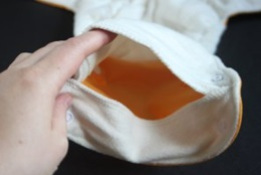
Pod: Another term for soaker (Padded Tush Stats, 2016).
Poppers: A British term for snaps.
Potty Learning: Similar to potty training, but the emphasis is on the child playing an active or leading role in becoming independent in the bathroom.
PPD: Abbreviation for “Paypal Dollars” or “Postage Paid.” This term is usually used when selling cloth diapers, and means that shipping costs are included in the price of the diaper (for example, “I’m selling this diaper for US$15ppd.”).
Prefold: Prefold diapers are rectangular pieces of cloth that have a thicker middle layer -- has multiple layers sewn down the middle. They are the type of diapers most commonly used before the invention of the modern-day cloth diaper. Prefolds are another budget friendly diaper and require a diaper cover or plastic pant (yes, they still make those too) to keep wetness contained. Prefolds may be trifolded and used like an insert or may be folded and pinned (or snappied) to secure onto your baby. Most prefolds are made of natural fibers like organic cotton, hemp, or bamboo.
Photo Credit: Padded Tush Stats
Prefold
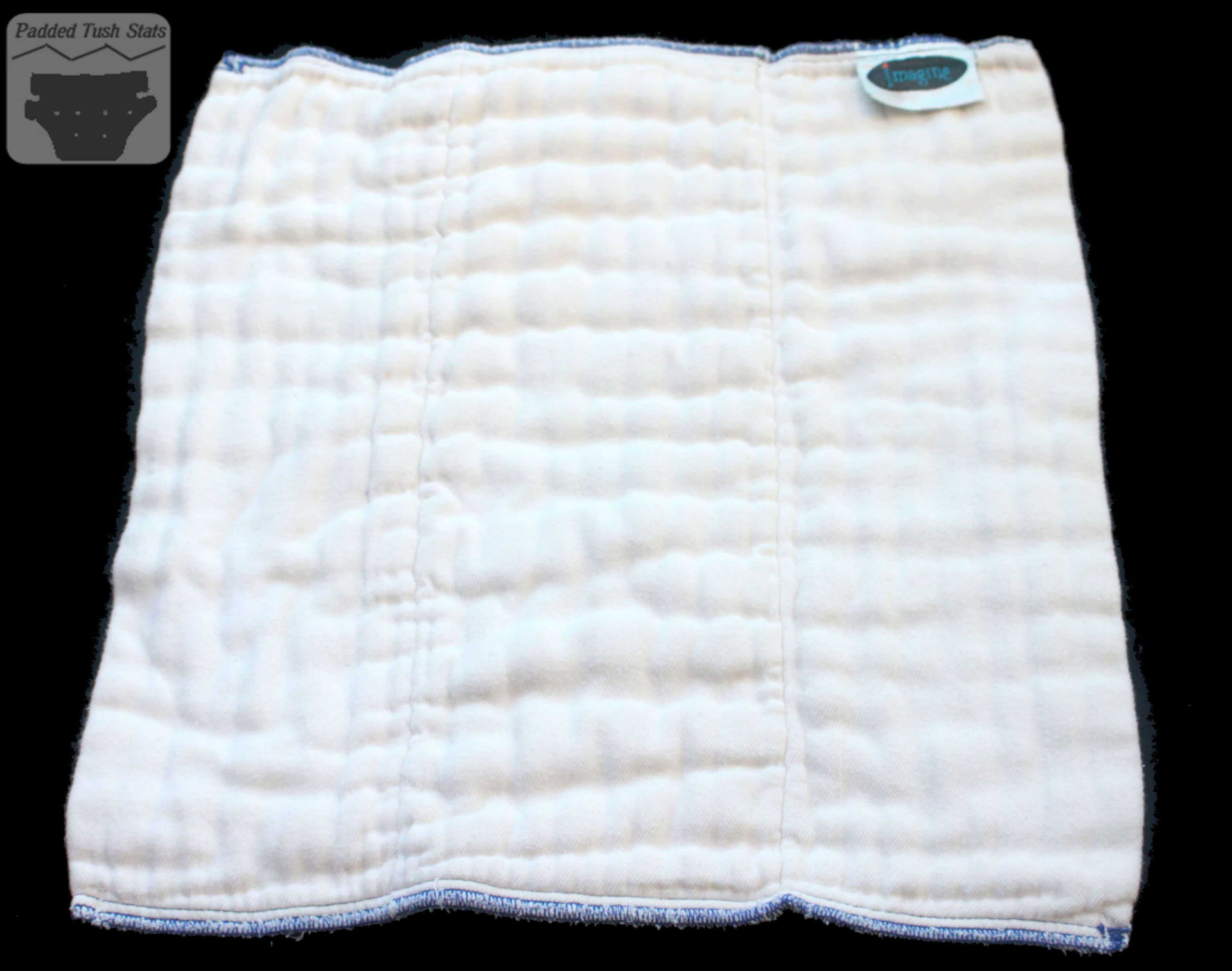
Prepping: The process of preparing a new cloth diaper(s). The preparation is meant to make it ready for use. Depending on the fabric, this could involve 1-5 wash cycles. The purpose of prepping is to remove natural oils or manufacturing dust before putting a new diaper to use. Diapers used before being fully prepped may not be as absorbent as they will after repeated washing.
Pre-wash: A brief agitation cycle or short wash cycle done prior to washing diapers with detergent. It helps rinse away ammonia and other impurities on the diapers and prevents staining prior to the wash cycle (Padded Tush Stats, 2016).
PT: Abbreviation for “Potty Training.”
PUL: PUL stands for polyurethane laminate — it comprises around 73% polyester and 27% polyurethane. PUL is the waterproof material used to make outer shells of diapers and diaper covers. Polyester is laminated to a layer of polyurethane. This process makes the fabric durable and waterproof, which is why it is used in the construction of diapers, potty training pants, changing mats, sanitary pads, nursing pads, wet/dry bags, baby bibs, and among other products. PUL is made with a "green" adhesive that is solvent-free, environmentally friendly, and releases no volatile organics. More particularly, polyester is paired with thermoplastic polyurethane (TPU), a thin stretchy plastic film. These two components are bonded together (into a single PUL fabric) using a combination of heat, pressure, and adhesive (Padded Tush Stats, 2016).
Photo Credit: Padded Tush Stats
PUL
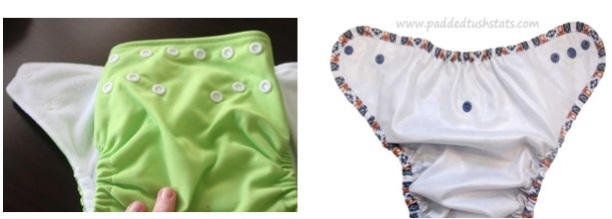
Q
R
R&W: Abbreviation for “Rinse and Wring.”
Rapid Pee-er: Baby may not necessarily pee a lot, but leaks are experienced because they pee too quickly for a diaper to absorb. Microfiber is often a great choice for rapid peers because it absorbs quickly (Padded Tush Stats, 2016).
Rash Prone: The term associated with babies that are easily susceptible to diaper rash or have chronic diaper rash problems. Many parents have chosen to switch to cloth diapers due to their baby being rash prone, especially when the proneness to rash is associated with disposable diapers.
Raw Silk Liners: Silk is a natural wicking material that help keep babies' bottoms drier. Silk has anti-bacterial properties that may keep yeast and diaper rash away. Although expensive, silk is very thin and would not add any bulk to your diapers. Silk may be used with any style of cloth diapers; especially effective when used with natural fibers (Padded Tush Stats, 2016).
Red Marks: Pink or red marks left on the baby’s skin at the waist or leg holes of a diaper. It is more typically an indication that the diaper is fitting too tightly in the area where the marks occur.
Repelling: When a part or all of a diaper repels moisture instead of absorbing it, leading to leaks. This can be caused by detergent, mineral, or diaper cream buildup.
Rinse and Wring: A method for preventing ammonia buildup in diapers by rinsing urine from the inserts immediately after a diaper change (with a diaper sprayer or faucet) and wringing out the excess liquid. This prevents the urea in the urine from converting to ammonia while sitting in a diaper pail.
RLR: A high-foaming laundry additive with proprietary (though purportedly natural) ingredients that is commonly used for occasional stripping of cloth diapers. It is especially useful for removing mineral buildup left from hard water. RLR comes in single use packets and is sold through many major cloth diaper retailers.
RnG: Abbreviation for “Rockin’ Green,” a brand of cloth diaper detergent (Padded Tush Stats, 2016).
Ruffled Elastic: A form of providing elastic around the gussets of the waist and legs of a diaper that looks like this:
Photo Credit: Padded Tush Stats
Ruffled Elastic
S
Serged: A serged diaper is the opposite of a turned and topstitched diaper (See “Turned and Topstitched”). The edges/threading are exposed and sewn over with a serger and look “ruffled.”
Photo Credit: Padded Tush Stats
Serged
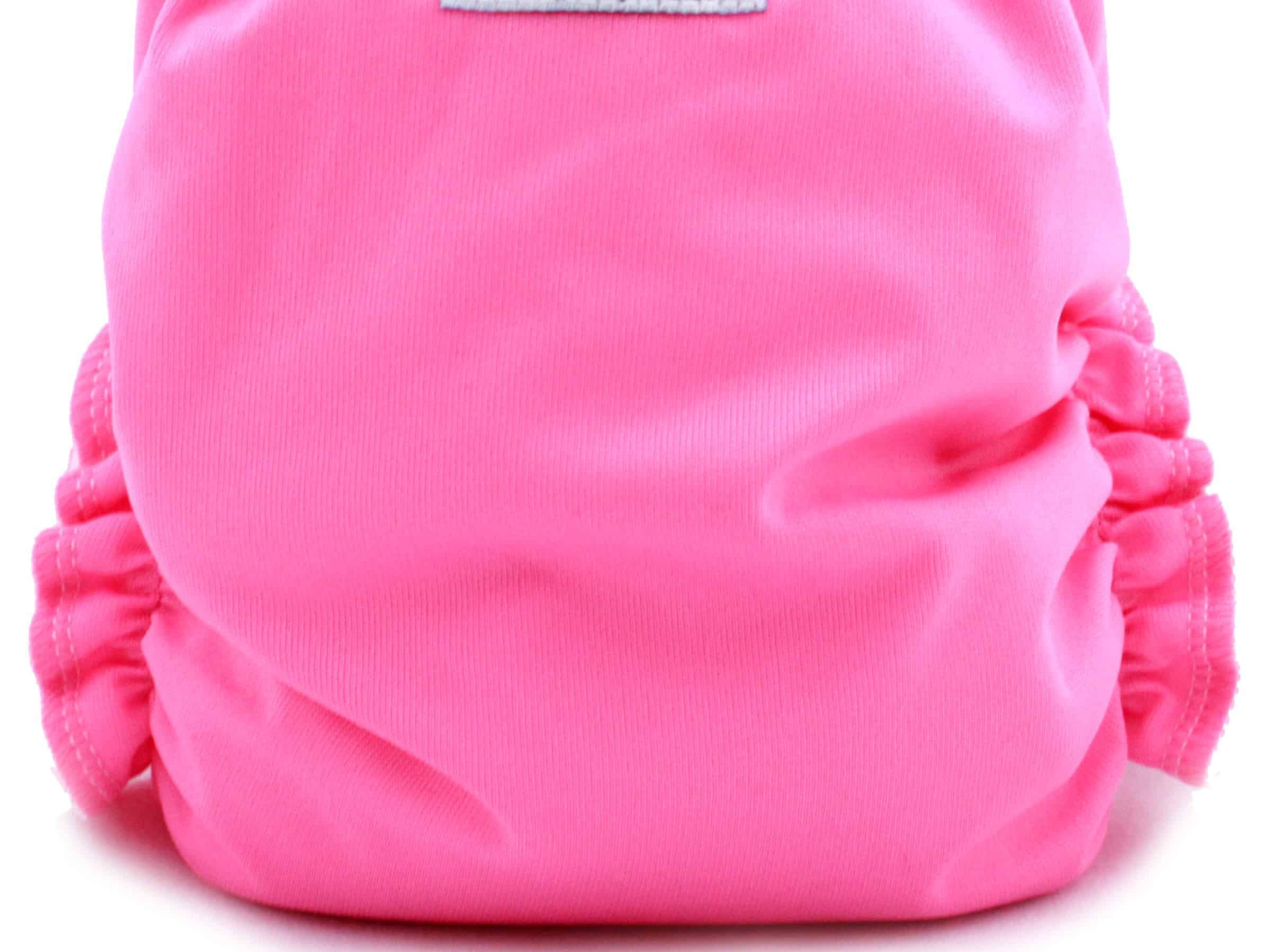
Shell: Another term for diaper cover.
Sherpa: A soft and absorbent breathable fabric (which is good for rash prevention). Sherpa has a textured surface on one side and a smooth backside. Some people like to use this fabric in reusable sanitary pads and cloth wipes.
Photo Credit: Padded Tush Stats
Sherpa
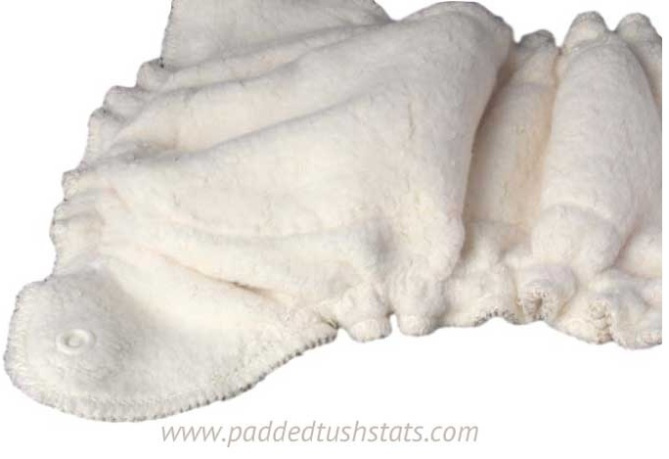
Shorties: These are wool or fleece shorts that can be used to cover a diaper that is not waterproof.
Photo Credit: Padded Tush Stats
Short
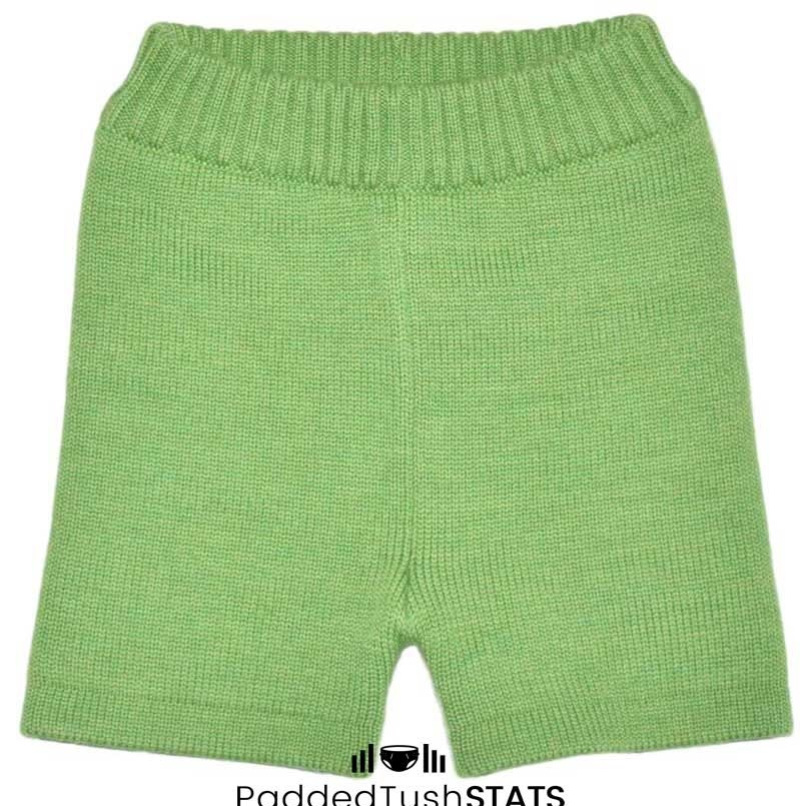
SIO: Abbreviation for “Snap-in-one” (Padded Tush Stats, 2016).
Skirties: These are wool or fleece skirts with an attached wool soaker underneath (the skirt is fashionable, and the soaker is functional). They are used as a cover for diapers that are not waterproof.
Snap Down Rise: This is when there are rows of snaps in the front of a diaper to allow you to adjust the sizing.
Photo Credit: Padded Tush Stats
Snap Down Rise
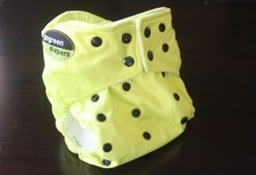
Snap Fastener: A pair of interlocking discs, made out of plastic used to fasten a cloth diaper.
Sized or Perfect-size: Sized diapers come in sizes (vs. one-sizes, which are adjustable). Sized diapers have the ability to fit babies slightly better, but will need to be replaced with larger sizes as your baby grows. Sizes typically include XS, S, M, L, and XL.
Snap-in-one: A diaper where the insides snap into the shell or cover. Much like an all-in-one except the insides can be removed for faster drying time and customization of absorbency.
Photo Credit: Padded Tush Stats
Snap-in-one
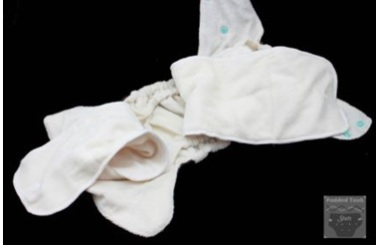
Snappi: A plastic t-shaped device with grabbers on each end that allow you to fasten prefolds, fitteds, and snapless diapers (instead of using diaper pins).
Photo Credit: Padded Tush Stats
Snappi
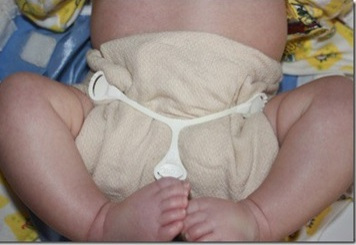
Snaps: A type of diaper closure. Diapers commonly come with snap or hook and loop closures.
Photo Credit: Padded Tush Stats
Snaps
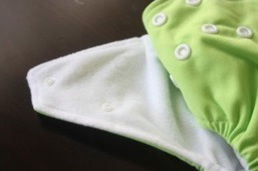
Soaker: (1) The absorbent part of a diaper, either sewn-in or added in the form of a booster or insert. (2) Frequently seen as “wool soaker” or “fleece soaker,” it is a type of cover that is pulled on over a prefold or fitted diaper.
Photo Credit: Padded Tush Stats
Soakers
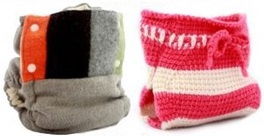
Soap Nuts: A berry native to two countries: India and Nepal. The berry has a natural detergent. Soap nuts are used in place of traditional laundry soap.
Spray Pal: A device that assists in the spraying of poopy diapers so that you do not have to touch the diaper or risk backspray. It has a clip to hold the diaper and sides to contain the spray, which also aid in squeezing excess water from the diaper when you are finished spraying.
Photo Credit: Padded Tush Stats
Spray Pal
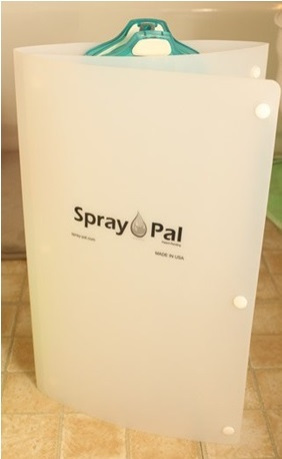
Sposies: Slang term for disposable diaper.
Stash: Slang term for all diapers you own. Examples: I have 30 diapers in my stash. My stash is primarily made up of pocket diapers
Stash Content: A slang phrase that means a mother is perfectly happy with her current diapering system and is not looking to buy, sell, or trade (that is, being content with one’s cloth diaper stash).
Stay-dry Material: The inner material is a layer of fabric between the baby’s skin and the absorbent insert. The quality of your "stay-dry" material is crucial in a modern-day cloth nappy. The material could either be microfleece cloth, suede cloth, microchamois, bamboo charcoal, bamboo terry, or bamboo cotton. This material does not have absorbent characteristics, but rather is used to repel liquid or wick moisture away from the skin to keep baby feeling dry — it gives the baby a stay-dry feel. When used in a diaper, the urine is supposed to pass through the inner material and absorb into the absorbent layers of the insert. The stay-dry nature of these materials will keep a baby feeling dry, even when they have a wet insert.
Microfleece fabric is soft and cozy against the skin, while wicking away moisture to give skin a stay-dry feeling (WIP, 2015). Microfleece also resists staining and does not hold on to poo like other fabrics do. Microfleece is our personal favorite because of the stay-dry feeling and because it is so soft and cushy. Suede cloth is cooler and less bulky, often preferred in warmer climates and times of the year. As compared to suede cloth, microfleece is known for being the softer and fluffier.
Suede cloth is great for custom diaper inners because provides the same stay-dry feeling as microfleece, but is trimmer. Like microfleece, suede cloth also resists staining and does not hold on to poo like other fabrics do. We love suede cloth for its soft trimmness.
Microchamois is used as the layer closest to baby's skin. It does not absorb any moisture, but instead wicks it through into the absorbent part of the diaper, and away from baby's skin. Because it does not absorb moisture, it feels dry, keeping baby's skin dry. As compared to suede cloth, microchamois is known for being the softer and fluffier.
Bamboo cotton is a blend material that contains 80% bamboo and 20% cotton (or 70% bamboo and 30% cotton). Bamboo is a popular option for cloth diapers. It wicks moisture away quickly, and can keep your baby comfortable even when wet.
Bamboo charcoal is made with a process of heating the bamboo to charcoal and then processing it into fibers. It is stay dry, which means it will wick moisture away from your baby's skin and the fabric will still feel dry even when wet.
Photo Credit: Padded Tush Stats
Stay-dry Material
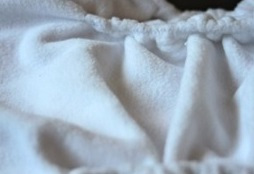
Stink: When used in the context of cloth diapers, this refers to odors that linger in washed, clean diapers or become noticeable once the diaper has been peed in (the most common of which are “ammonia stink” and “barnyard stink”). When diapers retain odors, it can be an indication that stripping is needed. (See “Stripping Diapers”)
Stripping Diapers: Removing built-up residue from cloth diapers.
Stuff: The act of placing an insert inside the sewn-in sleeve of a pocket diaper.
Stuffins: Another term for an insert, doubler, or some other absorbent material added to a cloth diaper to increase absorbency.
Suede Cloth: A nonabsorbent, synthetic material usually used on the inside of pocket diapers. It wicks moisture away from the baby and into the insert underneath, leaving baby with a “stay-dry” feeling and preventing rashes. (See “Stay Dry”)
Photo Credit: Padded Tush Stats
Suede Cloth
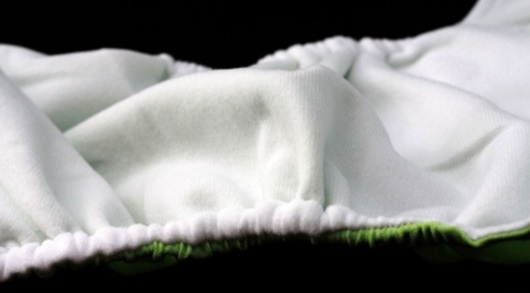
Sunning Diapers: Removing stains from diapers by hanging or placing wet inserts, diapers… outside in the sun or in a sunny window. The sunlight bleaches the fabrics and naturally removes stains.
Photo Credit: Padded Tush Stats
Sunning Diapers
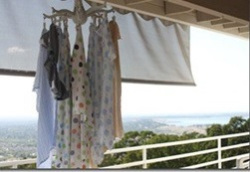
Swish Stick: A stick used to swirl the disposable insert in the toilet before flushing. This helps break down the insert and allows it to flush easier (Padded Tush Stats, 2016).
T
T&T: Abbreviation for “Turned and Topstitched.” (See “Turned and Topstitched”)
Tea Tree Oil: An essential oil from Australia that has antimicrobial property and is commonly used to disinfect or deodorize cloth diapers naturally. Tea tree oil can be added to wipes solution, butt balm, diaper pails, and your washer to prevent problems, such as rash and stinkies; and should always be diluted.
TL: Abbreviation for “Top Loading Washing Machine.” Some TLs are also HEs, but most are not.
Touch Tape: Another term for “Hook and Loop.” (See “Hook and Loop”)
TPU: TPU stands for thermoplastic polyurethane, a waterproof material that is heat bonded onto fabric. TPU requires a heat bond (instead of a chemical bond like PUL) and is claimed to be biodegradable. The TPU lamination film is also very safe for human health. It feels softer and less plasticky as compared to PUL. Caution should be used when washing TPU; it is recommended to wash using cool water and dry outside in the sun.
Photo Credit: Padded Tush Stats
TPU
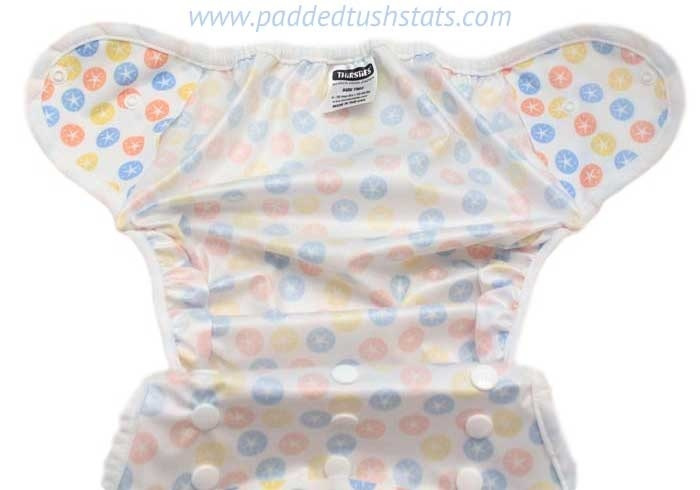
Trainer: A waterproof undergarment for toddlers and children who are potty training. Can be pulled up and down, and may have side snaps for easy removal in case of accidents. They vary in absorbency, and many can be customized by adding doubler(s) or booster insert(s).
Photo Credit: Padded Tush Stats
Trainer
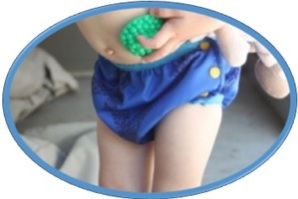
Trifold: Trifolding is a simple way to use a prefold in a diaper cover without using a Snappi, diaper pin, or other fastener. The prefold is folded into thirds (with the thickest part in the center) and placed in a cover, which is then attached around the baby.
Photo Credit: Padded Tush Stats
Trifold
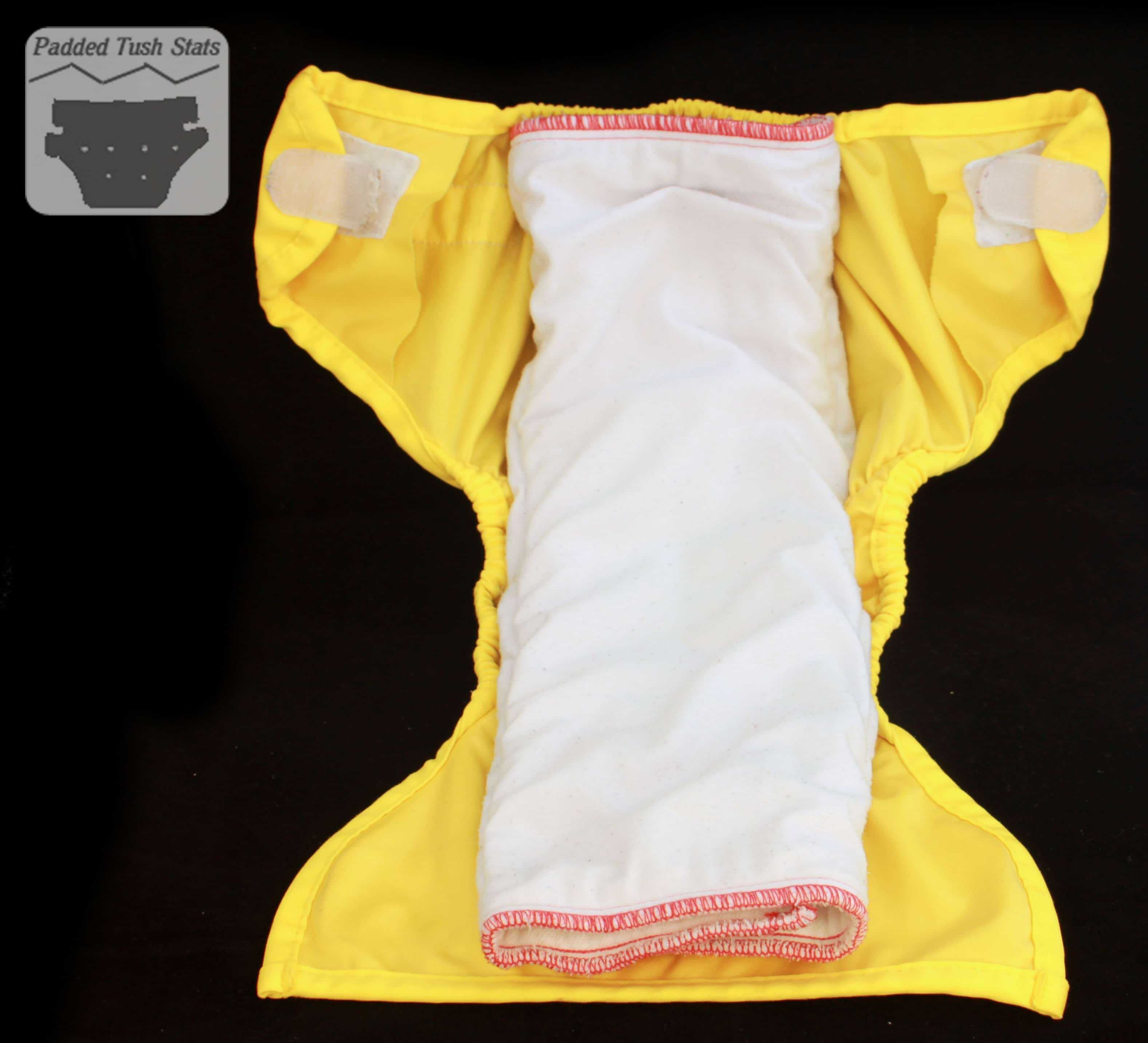
TTO: Abbreviation for “Tea Tree Oil”. (See “Tea Tree Oil”)
Two-step: Term used to describe diaper brands that are not made to fit babies from birth to potty training, but have two sizes of diapers. The size 1 will usually fit much better on a newborn than a normal one size diaper, and the size 2 will usually fit a toddler with more coverage.
Turned and Topstitched: The opposite of a serged diaper. (see “Serged”). This term is most often used in reference to a fitted diaper. A turned and topstitched diaper will have a clean edge with no exposed threads or “ruffles” (Padded Tush Stats, 2016).
Photo Credit: Padded Tush Stats
Turned and Topstitched
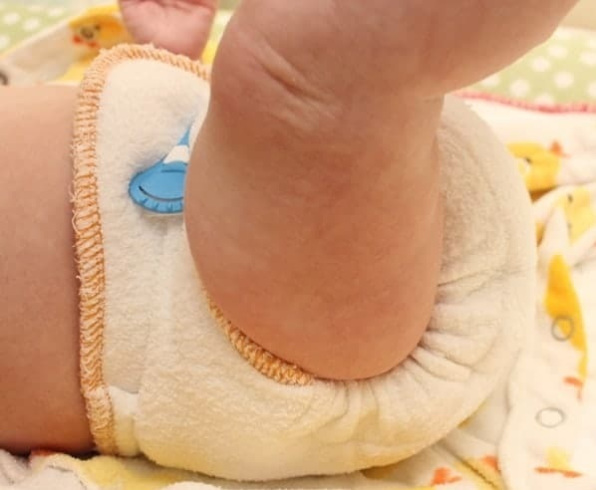
U
UB: Abbreviation for “Unbleached.” (See “Unbleached”)
UBCPF: Abbreviation for “Unbleached Chinese Prefold.”
Unbleached: A fabric that has not been bleached to make it bright white, making it khaki/tan colored.
Photo Credit: Padded Tush Stats
Unbleached
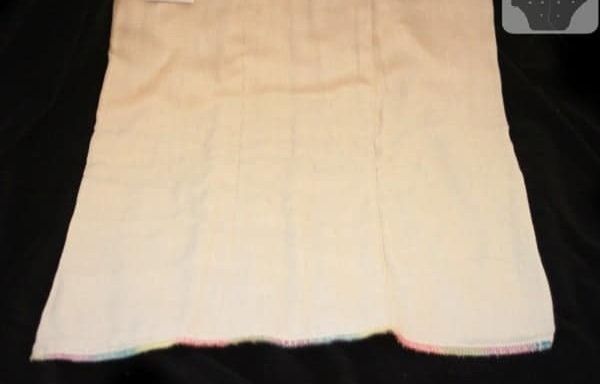
Un-encased Elastic: A method of sewing the elastic around the legs of a diaper involving securing each end of the elastic, but not sewing a channel for the elastic to go through (similar to what is on encased elastics).
Photo Credit: Padded Tush Stats
Un-encased Elastic
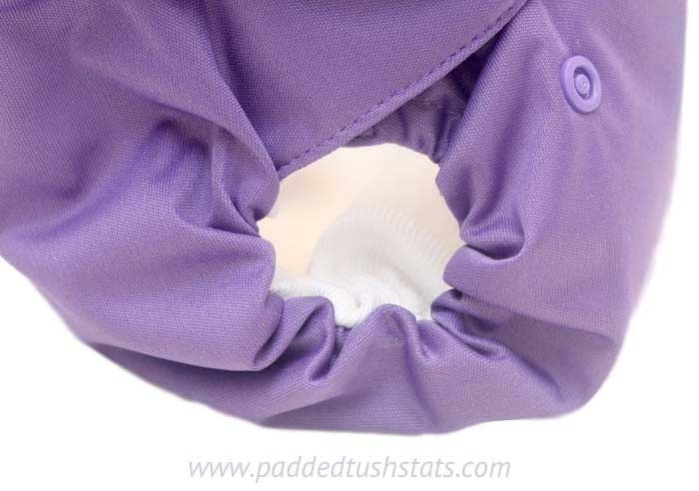
Upcycle: The act of converting used or unwanted textiles into new diapers and accessories of better quality (for example, wool sweaters are frequently upcycled into diaper covers) (Padded Tush Stats, 2016).
Urine: Urine is roughly 95 percent water and five (5) percent waste products. Nitrogenous wastes excreted in urine comprise ammonia and creatinine. Others are urea and uric acid. Ions are also excreted. Among them are sodium and potassium. Others are hydrogen and calcium (University of Cincinnati, n.d.).
V
Velour: A very plush and thick knitted fabric that can be made of either cotton or synthetics.
Photo Credit: Padded Tush Stats
Velour
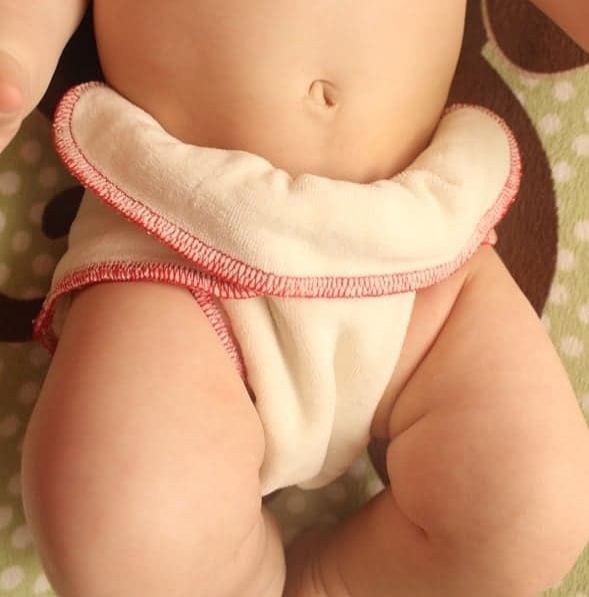
VGUC: Abbreviation for “Very Good Used Condition,” a way to classify a diaper’s condition when selling it.
Vinegar: White vinegar is sometimes used as a natural additive to soften diapers and get rid of smells. It is generally thought to be quite safe for use with soft water. However, although vinegar can act as a natural water softener for hard water and some cloth mamas use it very successfully for that purpose, many feel that it is best to avoid it for this purpose, since the acid from the vinegar can sometimes react with hard water minerals to cause a strange, unpleasant odor.
Vinyl Pants: Another term for “Plastic Pants.” (See “Plastic Pants”) (Padded Tush Stats, 2016).
W
Waterproof Outer Shell: Soft, waterproof outer PUL (polyurethane laminate) fabric laminated with TPU (thermoplastic polyurethane) forms a water-proof barrier. PUL is stain and odor resistant, machine washable, durable, and comfortable. Also, PUL is breathable, soft, waterproof, and stretchable fabric. Prints remain bright and colorful wash after wash. Minky PUL fabric is like fleece, but softer and thicker. The high quality of minky fabric prevents its colors from fading and its warmth from decreasing over time.
Wet Bag: A wet bag is a small reusable bag used for storing soiled diapers. Wet bags can be used at home or when on-the-go and come in small to large sizes. Wet bags are waterproof and are sealed with either a zipper or drawstring closure to keep the messy stuff inside. You can wash wet bags with your diapers when you get home.
Photo Credit: Padded Tush Stats
Wet Bag
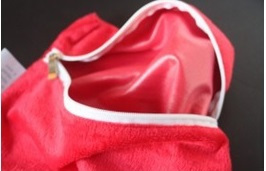
Wet/Dry Bag: A wet bag with a second pocket (which may or may not be waterproof) that can be used to carry clean diapers or other diaper changing accessories. This allows you to carry the items you need for a diaper change and store your dirty diapers in the same location (which is convenient for traveling and outings).
Wet Pail: A diaper pail full of water (and possibly detergent or other additives) sometimes used to store dirty diapers before wash day. Many within the cloth diapering community feel that these are unnecessary and promote bacterial growth within the diapers, as well as other problems. Owners must be sure the the pail has a securely fastened lid that cannot be opened by curious toddlers, as it could be a drowning hazard.
Wicking: Wicking is the transfer of moisture. The moisture moves from one place to another place. It is good when moisture is wicked away from a baby’s skin through a stay-dry fabric like microfleece, suede cloth, microchamois, bamboo, or athletic wicking material. Wicking is a bad thing when moisture finds a weak spot or exposed area to leak out of. For example, if your pocket insert is not fully tucked in a diaper, the wet insert will wick (transfer) to clothing or the outer fabric of the diaper. Or, if the inner fabric around baby’s legs is not rolled in, moisture will wick to clothing, sheets, furniture… Another very common instance of wicking occurs during oversaturation of the soaker material. This crosses over into more of a leaking issue, but the same concept occurs. At this point, the moisture can transfer freely to the stitching and then outer fabric. All of this is easily visualized when considering how the capillaries in our body work or if you have ever performed carnation and dye experiment. How do you prevent wicking? Make sure everything is tucked in nice and neat to the waterproof cover and change your baby(ies) often.
Wing Droop: When a diaper is placed on a small waist setting and there is excess fabric in the “wings” of the front of the diaper, those wings can then droop or sag. Some diapers have additional waist snaps in order to prevent wing droop.
WIO: Abbreviation for “Wool in One.” (See “Wool in One”)
Wipe Bits: Another term for “wipe solution cubes.” (See “Wipe Solution Cubes”)
Wipe Solution: A liquid solution used to moisten cloth wipes. The solution can be store bought or homemade.
Wipe Solution Cubes: Solid cubes that are dissolved in water to make a wipe solution. (See “Wipe Solution”)
Photo Credit: Padded Tush Stats
Wipe Solution Cubes
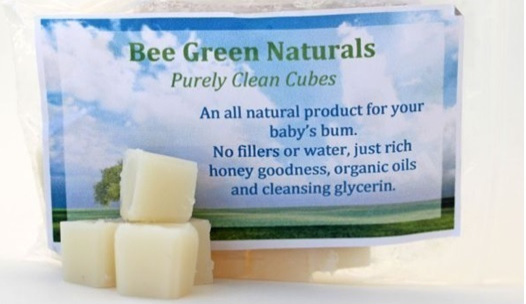
Wipe Warmer: A device that stores and heats wipes (either cloth or disposable). Some wipe warmers are made specifically for use with cloth wipes, though regular wipe warmers intended for disposable wipes can be used with cloth as well.
Wipeable Inner/interior: A waterproof diaper cover that has exposed PUL or TPU on the inside. The inside is not lined with fabric or mesh and can be easily wiped clean for another use without immediate need for washing. (Reuse without washing is not recommended when poop has leaked onto the cover).
Photo Credit: Padded Tush Stats
Wipeable Inner
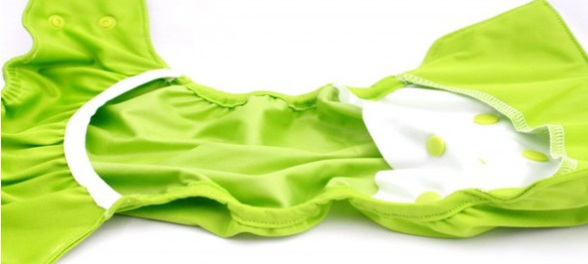
Wool: Wool is often referred to as bulletproof in the cloth diapering community. Wool is used to make diaper covers, longies (long pants), and shorties (short pants or skirts) to go over prefolds, flats, or fitted diapers. Wool is a natural fiber that is extremely breathable and is commonly used for nights, naps, and for heavy wetters. Wool covers can be hand knit or purchased. Wool needs to be lanolized in order for it to have that superior waterproof characteristic and extreme care should be followed (check with the manufacturer) when washing to prevent shrinking your wool.
Wool-in-one: A diaper that is an all-in-one, except that the outside is made out of wool. (See “All-in-one”)
Wool Soaker: A diaper cover that is made of wool. (See “Soaker”)
Wool Wash: A special detergent that is used to launder wool. Many, though not all, wool washes contain lanolin, which helps extend the length of time you can go before needing to re-lanolize your diaper covers.
Woolies: Slang term for any diaper cover made from wool.
Wrap: Another term for “cover.” (See “Covers”) (Padded Tush Stats, 2016).
X
Y
Z
Zinc Oxide: An ingredient in some traditional diaper rash ointments. Because zinc oxide creates a moisture barrier, it is not safe for cloth diapers (Padded Tush Stats, 2016).
References
Please click on (or tap on) the following link to access/view the "References": References -- Cloth Diapers Dictionary.doc